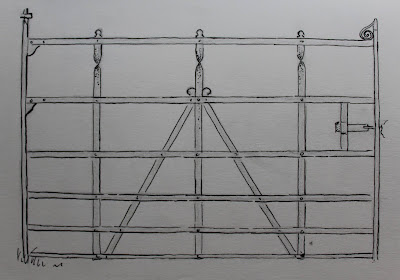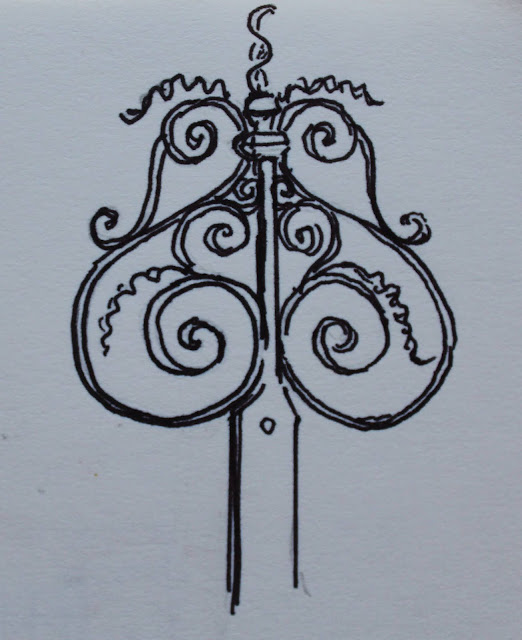 |
| Drawing of Dungarvan Bridge by William Fraher |
In our new series museum curator Willie Fraher looks
at the variety of stonework which can be seen in buildings and walls around
Dungarvan. Much of it is from local
quarries and predominantly limestone, but there is also granite and sandstone
and imported stone from England. In
Dungarvan Castle there are still some traces of Dundry Stone imported from
Bristol and Dungarvan Bridge is composed of stone from Runcorn in
Cheshire. The major reconstruction of
the town centre in the early 19th century required large quantities
of stone so two limestone quarries were dug, one in Dungarvan (on either side
of the upper part of Mary Street) and the other in Abbeyside.
It is worth looking at the detail in how the stone is
finished, sometimes rubble stone, in other cases as in the façade of the Old
Provincial Bank it is finely dressed.
There were a number of quarries outside Dungarvan and one which was
owned by the Villiers-Stuart family of Dromana supplied the stone for the tower
of the Augustinian Church. Carriglea
House is constructed of a pinkish sandstone from a nearby quarry.
We do know the names of some of the local stonemasons,
but they are not always documented.
Patrick McGrath (1812-1895) had a stone yard at South Terrace in the
1830s. As a young apprentice he worked
on the stonework at Strancally Castle in the late 1820s. He emigrated with his family to Quincy,
Massachusetts in 1847 where he established a stonework business.
The most common stone to be found in the Dungarvan
area is limestone with which most of the principle buildings are
constructed. The courthouse in T.F.
Meagher Street and St Mary’s Church of Ireland are good examples and the
decorative stone tracery of the windows in St Mary’s Parish Church.
‘On the Bridge I will linger, at sweet evening tide’
(Dungarvan My
Hometown, Mai O’Higgins)
Dungarvan
Bridge
This bridge was an important development for the
people of Dungarvan in the early 1800s.
Before its construction a person had to travel up to Ballyneety to cross
the River Colligan or pay to get the ferry from Abbeyside to Roderick’s Quay in
front of the castle. There was a
competition between the Duke of Devonshire and the Marquis of Waterford as to
who would get the bridge built first.
The marquis wanted the bridge to be funded by the Grand Jury and the
duke was willing to pay for it himself.
Most people were happy for the duke to fund the project which he
did. The architect William Atkinson
prepared a set of drawings which show a bridge of five arches and a
balustrade. Atkinson was told by the
Devonshire agent that the bridge should be built of Runcorn stone which was
cheaper than other available stone. The
cost of the bridge was estimated at about £8,000. In 1813 Samuel Ware was sent to Dungarvan to
inspect the initial foundations:
‘I found on the quay an immense quantity of freestone
brought from England at an expense I was informed of about 2 shillings per foot
cube. I saw part of an expensive block
cornice and architrave partly worked, and it appears by one of the drawings
that the bridge was intended to be finished suitably to a nobleman’s park or a
great city’. He was not happy with what
he saw and recommended a smaller structure of three arches. The final design consisted of only one arch
with the others replaced by a long causeway.
The engineer in charge of the project was Yorkshire native Jesse Hartley
(and builder of Liverpool Docks) who married local lady Ellen Penny while based
in Dungarvan to oversee the works between 1809 and 1818. The bridge was completed after much
difficulty and opened to the public in 1816.
It is a testament to the skills of the engineer and the stonemasons and
others who built it that it has survived the weather and heavy traffic of the
20th and 21st centuries.
Further reading:
The
Reconstruction of Dungarvan – 1807-c.1830 – A Political Ploy by William Fraher, Decies journal,
January 1984.
Jesse Hartley:
Dock Engineer to the Port of Liverpool 1824-60 by Nancy Richie- Noakes, 1980.
Irish Stone
Bridges- History and Heritage
by Peter O’Keefe and Tom Simington, 1991.
 |
| Drawing of Dungarvan Bridge by William Fraher |
 |
| Dungarvan Bridge in colour |
































